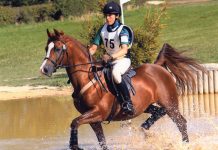Wendy Bliss, freelance coach and advanced sports therapist, writer of our Enhanced Riding series, is now offering readers the exciting opportunity to email their questions directly and receive a personal reply published in the online magazine. We may not be able to reply to all questions every month if demand is high, but be assured that a variety of training issues will be addressed in our new Question and Answer section.
Do you have a training issue with your horse? Do you feel you need some inspiration or are you suffering from confidence issues with your riding? Would you like some tips and advice on your position or your horse’s behaviour?
Sometimes we all need a little help, no matter how experienced we are. We invite you to share your problems and difficulties with us and we will try to help with practical advice. Together, the sky will be the limit.
Contact by email: info@thearabianmagazine.com
Hello readers, as this is the first running of the Training Q and A we will address some topics that have come up with my clients in recent weeks. I hope that if the issues are familiar, the advice will be helpful. Do get in touch with your training queries on email at info@thearabianmagazine.com
Q. No matter how hard I try, I can’t keep my feet in my stirrups. Or I can’t keep my stirrup on the ball of my foot. This happens particularly in canter and if I do sitting trot. Is there anything I can do to help with this?
Natasha, Liverpool
A. This is a very common problem and one that is often caused by tension, with the leg moving upwards and backwards when used. It is due to weakness of both core body strength and the adductor muscle at the inner thigh. When we place our legs around the horse we stretch the adductor which is often much underused in everyday life. When we have to give leg aids, the leg lifts up and the stirrup is ‘lost’.
If possible, try to work without stirrups, gently placing your legs around the horse’s sides. If this is not possible or safe then there are lots of exercises you can do dismounted to help develop your adductor and core strength. Try stomach crunches and back raises. Squats are good for strengthening your legs, as are leg raises. Lying on your side, lift up your top leg slowly, hold for a second or two and gently lower back down. Keep a bend in your knee and ensure your head is in line with your spine, and repeat for a set of repetitions and on each side.
While riding, ensure you are stretching up with your upper body and relaxing down with open hips and knees, with no gripping or bending the leg upwards to use it. Think of your stirrup as a gentle foot rest and your ankle as very relaxed so your heel naturally lowers as the horse moves.
Remember your muscles won’t become stronger overnight so keep practising.
Q. My horse does not find canter easy, how can I help develop his canter? He can canter on the lunge and picks up the correct leg but he sometimes drops back into trot and feels unbalanced when riding.
Joanne, Birmingham
A. I would recommend a variety of exercises to help your horse improve canter. The reason he falls back into trot may be that he is not using his hindquarters and is falling onto his forehand. Pole work exercises both in trot and canter are an excellent way of strengthening and helping with canter work. Try four poles on a 20 metre circle, set at 12 o’clock, 3 o’clock, 6 o’clock and 9 o’clock. Try cantering around the outside and then over them.
Simple lateral work such as turn on the forehand and leg yielding will also be of great benefit. Remember, to improve a pace we shouldn’t just go around the school over and over; instead, ride lots of transitions in different places and they will most definitely help. When cantering, aim for letters or circles to keep the canter going rather than just going around. In this way, you will be the one asking for trot.
Horses are habitual so if they think they can stop in a certain place then they will try it again, so be ready and change where you canter or ride more forward before he gets chance to slow down. Feeling what is going on underneath you is important.
See you next time!
Wendy Bliss www.clipandcanter.web.com
Disclaimer: All information is provided on an as-is basis and is for informational purposes only. The Arabian Magazine, www.clipandcanter.webs.com or Wendy Bliss make no representations as to the accuracy, completeness, currentness, suitability, or validity of the information and will not be liable for any losses, injuries, or damages arising from the display or use of the answers and information given.












